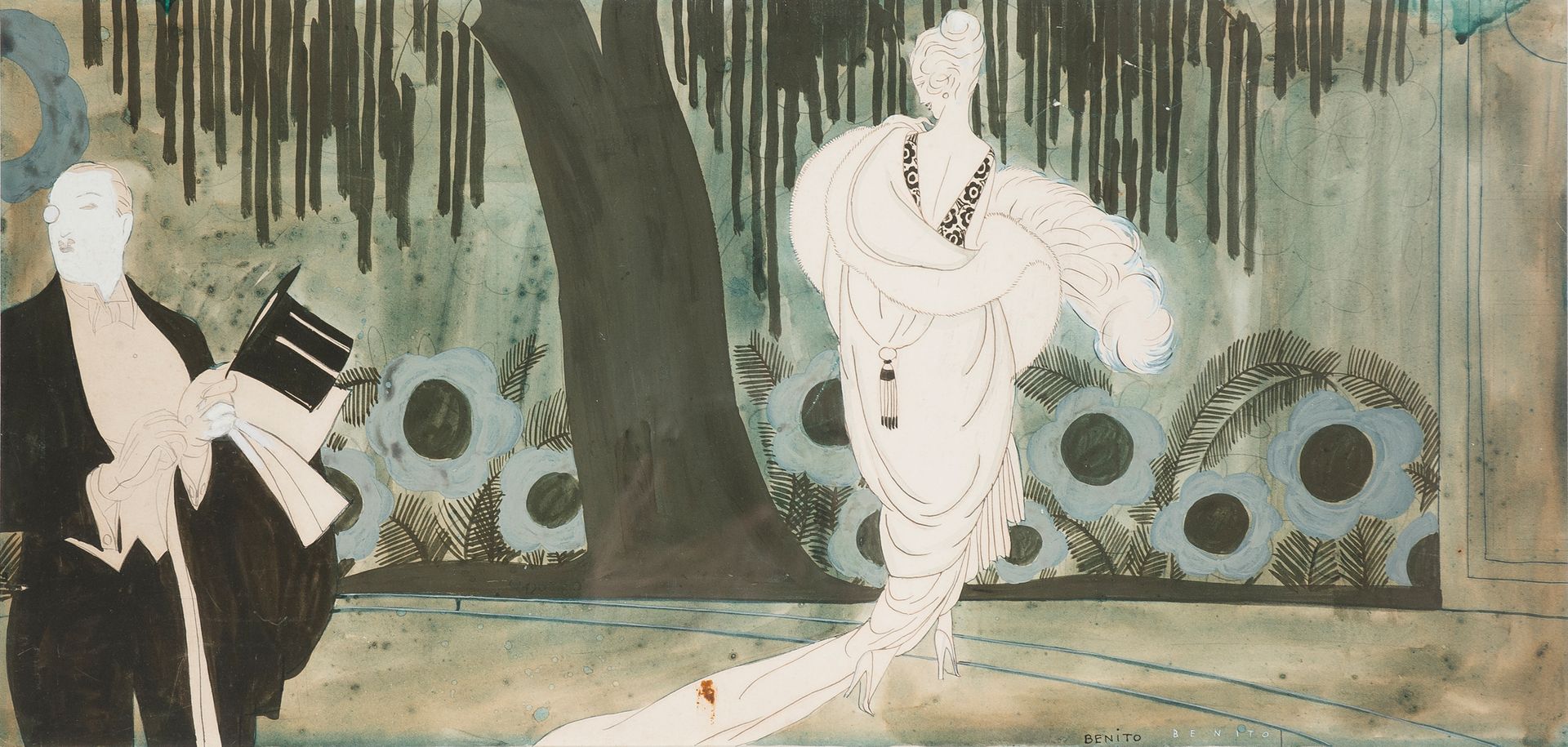Description
Eduardo García Benito (Valladolid, 1881 - 1981)
Eduardo García Benito (Valladolid, 1881 - 1981) "Pareja elegante, nocturno" (Elegant couple by night) Watercolour y gouache on paper. Signed. Circa 1920 - 25. 25,8 x 52,3 cm. The painter Eduardo García Benito (1891-1981) was one of the most renowned and polished artists of the Art Deco movement. Born in Valladolid, he trained at its School of Fine Arts and Crafts and, later, at the Academy of San Fernando in Madrid. He was given a grant by the City Council of Valladolid to go to Paris in 1912, a city where he socialised with the great masters of the time (Pablo Gargallo, Julio González, Pablo Picasso, Juan Gris, Raoul Dufy and Amedeo Modigliani). His knowledge of the various avant-garde movements that were being developed at the time (Fauvism, Cubism, Futurism, Expressionism) led him to develop an eclectic style to which he added personal elements. The interwar period, the Roaring Twenties, was the period in which he reached the peak of his career, largely due to his discovery by the famous French couturier Paul Poiret (1879-1944) -whom he painted together with his wife in 1921- who attracted the best stylistic illutrators of the time to his company. Poiret, who had introduced revolutionary changes in women's clothing to suit the needs of the moment, took him under his wing and introduced him to the sophisticated and elegant world of the international fashion publications and magazines of Paris and New York: "Fémina" and the "Gazette du Bon Ton" in Paris and "Vanity Fair" and "Vogue" in New York. When Condè Nast (1873-1942) took over the Gazette du Bon Ton, he hired a number of illustrators, among whom was Benito -which is how our artist liked to sign his work- whom Nast himself came to describe as the most talented of all. Nast also owned Vanity Fair and Vogue, undoubtedly the most influential fashion publications, and required reading for the elite for almost a century, for which Benito made more than 100 covers between 1921-1940, in addition to exquisite illustrations and figurines. For "Vogue" he created striking covers in which he impressively combined geometry with colour contrasts. His style was defined by 1925. From that time his illustrations for these magazines stood out for the perfection of the drawing and their straight lines, the balance of proportions and the harmony of the whole. His characters are austere, stylized, geometric and elegant, with a crystalline structure and sculptural and cubist faces, all characteristics that contributed decisively to the forming and dissemination of Art Deco. In the clothing of the moment there was a trend towards internal freedom and comfort, and that is precisely what we can observe in Benito's drawings and sketches: light images capturing woman in the process of liberation -the old corsets and whale sashes were discarded- which created that languid and stylized image that fitted perfectly with the atmosphere of sophistication and frivolity of the time. The article dedicated to Benito by the writer Francisco de Cossío in the newspaper El Norte de Castilla in its issue of August 30, 1929 on the contribution of Benito to the world of fashion of the twenties is very significant. It reads: "To what extent is fashion a superficial art? García Benito finds the greatest inspiration for his creations in the grace of the elegant woman. Being, in a way, an auxiliary to the great couturiers, he knows how to raise the standard of his art by conquering the covers of the most elegant magazines in the world. The modern mannequin, stylized, shiny gold and silver, which brings us the memory of oriental idols, is his work. Creating for women, not only fabrics and colours, but attitudes, smiles, postures, rhythms … Elegant women come to García Benito's drawings to learn the secret of suggestion in modern elegance… ". From 1923 he lived alternately in Paris and New York, and in 1958 he returned to his hometown, bringing his most original artistic cycle to a close, although he continued to paint and work. The fact that the Congress of the United States, in the session of February 8, 1974, voted a motion of congratulations to Benito for his cultural work in that country is another proof of the level of importance that our artist attained. We would like to thank Javier Baladrón, doctor in History of Art, for cataloguing this piece.
80
Eduardo García Benito (Valladolid, 1881 - 1981)
